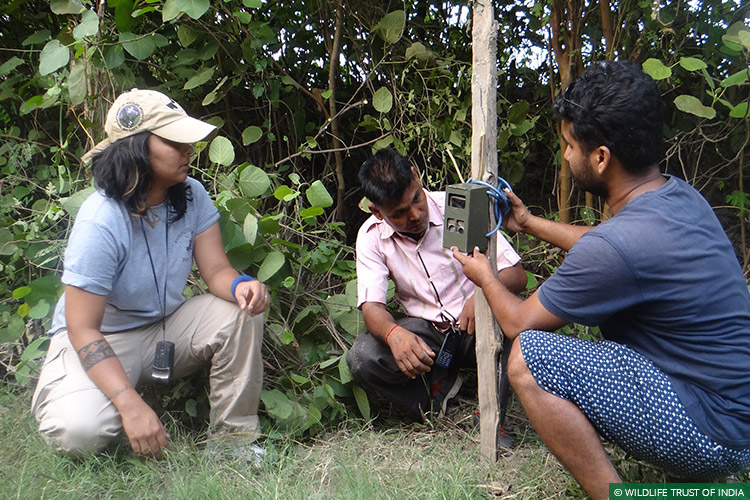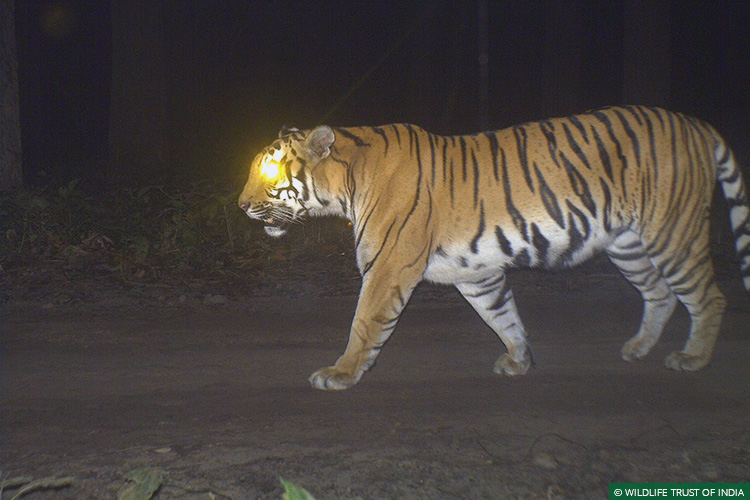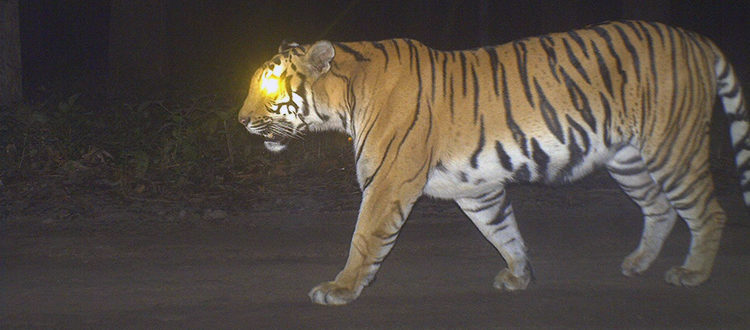Burning Bright
By Francis Ishmael
Tyger Tyger, burning bright, In the forests of the night; What immortal hand or eye, Could frame thy fearful symmetry?
~ William Blake, ‘The Tyger’, 1794
What is a tiger? Is it beautiful? Awe-invoking? The stuff of poetry? Or is it a vicious creature, perpetually out for blood?
I knew not, until I saw one for the first time in my life.
I had recently taken up the post of Field Biologist in Wildlife Trust of India’s Terai Tiger Project, based out of Dudhwa and Pilibhit Tiger Reserves in Uttar Pradesh. My previous conservation experience had given me the opportunity to observe elephants at close quarters, and I had learnt of the gentle nature, and the human-like emotions of those giant herbivores.
In this project, though, I found myself perpetually on the trail of tigers and leopards – creatures that are in the popular imagination labelled ‘bloodthirsty’ or ‘dangerous to human existence’. I lived with those labels too, until one fateful day when I headed out with my team towards Katerniaghat Wildlife Sanctuary (a part of Dudhwa Tiger Reserve) to address a human-leopard conflict case, brought to our attention by the Field Director of Dudhwa Tiger Reserve.
My colleagues and I constitute a Rapid Response Team (RRT) that addresses human-large carnivore conflict in the Dudhwa-Pilibhit landscape, mostly by engaging with and sensitising people afflicted by such conflict, but also, when the need arises, by capturing animals – usually tigers and leopards – that are ritually attacking humans.
 The author and his RRT colleagues installing camera traps at the site of a leopard attack in Katerniaghat WLS
The author and his RRT colleagues installing camera traps at the site of a leopard attack in Katerniaghat WLS
The leopard involved in this incident was said have attacked two children within a span of 48 hours in Puraina village, near Amritpur in the Motipur range of Katerniaghat. The villagers were reportedly quite agitated; they wanted the ‘culprit’ captured (or killed) and removed from the area for good. Soon after reaching the village, our team arranged a series of meetings with the residents. An awareness camp was organised to sensitise them about subtle behavioural changes that they could make to reduce unwanted interactions with their wild neighbours. While this effort was underway, RRT veterinarian Dr. Reetika Maheshwary and I began to survey the site of the attack and reconstruct the incident from the tell-tale signs we were able to find. We also installed camera traps (motion-triggered cameras) in the area so that we could identify the leopard and study its movement patterns.
The tiger watched us with what seemed to be a questioning gaze. ‘What do you want here, in my home?’ it seemed to say; ‘I’m hungry and have to leave for a hunt’.
At the end of a strenuous day and with no leopard having been sighted anywhere, we decided to head to the Motipur Range’s forest rest house, a little over 10 kilometres away, where the UP Forest Department had generously allowed us to put up for the night. We would have another long day tomorrow, following up on the confidence building measures we had initiated with the aggrieved villagers of Puraina.
We drove out of the village in our creaking Bolero camper (which is over 12 years old!) and headed into the wilderness of Katerniaghat. The vehicle juddered and groaned through the silent jungle, and our eyes instinctively focussed on the bright spots created by the headlights, and occasionally on the patches of forest our flashlights illuminated. With the noise the camper was making, though, I doubted we would see any wildlife.
No sooner had I thought this than Karam Singh, our Field Assistant, whispered: “Wahan kuch to hai! Thoda piche lo” (There’s something there! Reverse a bit!). We reversed, and lo! We saw two red spots aglow in the undergrowth and then a full-grown tiger came into view! No more than six feet from our vehicle, emerging between two thick sal (Shorea robusta) trees, it seemed for some reason quite tolerant of our presence. Lit up under the headlights the tiger presented itself in its full glory for that sought-after ‘trophy photo’. I raised my camera and saw the picture I was about to click through its viewfinder. The infra-red focus lights seemed to catch the tiger’s attention (despite the blazing headlights), however, and it turned its head away. With a brief second thought I lowered the camera, giving up on that ‘once in a lifetime’ photograph. The tiger eased and stood watching us with what seemed to be a questioning gaze. ‘What do you want here, in my home?’ it seemed to say; ‘I’m hungry and have to leave for a hunt’.
 A camera trap image of a tiger in the same landscape (file photo)
A camera trap image of a tiger in the same landscape (file photo)
I wondered why it was so tolerant of our presence, even though we had disturbed it. Why did it not display even the slightest hint of aggression? As I mused, I heard Karam Singh ask: “Sir? Photo mila?” (Did you get a picture?). I replied with a soft ‘no’. “Aap ko photo kheechna nahi aata!” (You don’t know how to take pictures!) he retorted. I asked him to move on, leaving the tiger to its business.
As we rumbled through the jungle, I wondered if the tiger really knew the threat our kind posed to its kind. I wondered too if the ‘culprit’ leopard we were after was like this tiger, a rather benign creature of nature, merely trying to eke out an existence. It may have attacked the two children in self-defence or under extreme stress of hunger. We city-dwellers have almost forgotten what such pressures are, those basic survival urges that can drive even us, the ‘noble’ homo sapiens sapiens, to wreak unimaginable horrors on our own kind.
Why then do a few attacks by wild creatures like tigers and leopards on humans make them ‘bloodthirsty’? Why do we not see their plight amidst our pompous usurping existence?
I knew I had much food for thought. But my primeval instincts had kicked in. I was hungry and I had to eat; everything else would have to wait.
The author is a field biologist with Wildlife Trust of India’s Terai Tiger Project, run in the Dudhwa-Pilibhit landscape in partnership with the Uttar Pradesh Forest Department and with support from the US Fish and Wildlife Service









